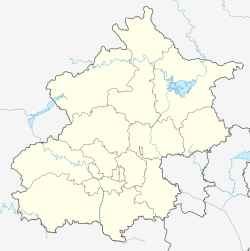Beijing Nanyuan Airport
Beijing Nanyuan Airport (IATA: NAY, ICAO: ZBNY) was a military/public airport that also formerly served as the secondary airport of Beijing. Located in Fengtai District, 3 kilometres (1.9 mi) south of the 4th Ring Road and 13 km (8.1 mi) from Tiananmen Square,[2] Nanyuan Airport was first opened in 1910, making it the oldest airport in China. It was the main hub of China United Airlines.[3]
Beijing Nanyuan Airport 北京南苑机场 | |||||||||||
|---|---|---|---|---|---|---|---|---|---|---|---|
| Summary | |||||||||||
| Airport type | Military (former public) | ||||||||||
| Serves | Beijing | ||||||||||
| Location | Fengtai District, Beijing | ||||||||||
| Opened | 1910 | ||||||||||
| Closed | 25 September 2019 | ||||||||||
| Coordinates | 39°47′03″N 116°23′39″E | ||||||||||
| Map | |||||||||||
 NAY Location in Beijing | |||||||||||
| Runways | |||||||||||
| |||||||||||
| Statistics (2018) | |||||||||||
| |||||||||||
Citations needed for all numerical figures above | |||||||||||
| Beijing Nanyuan Airport | |||||||||||||||
|---|---|---|---|---|---|---|---|---|---|---|---|---|---|---|---|
| Simplified Chinese | 北京南苑机场 | ||||||||||||||
| Traditional Chinese | 北京南苑機場 | ||||||||||||||
| Literal meaning | "South Garden Airport"[1] | ||||||||||||||
| |||||||||||||||
Nanyuan Airport ceased civil operation on 25 September 2019, after all flights were moved to the newly opened Beijing Daxing International Airport.[3]
History
The first aircraft landed in the Nanyuan area was in 1904. In July 1907, the government built rudimentary runways in Nanyuan's Yijun training ground (also known as the Wulidian soldier training ground) and used it for a light aircraft purchased from France.[4]
In August 1910, the Qing government began to establish air transportation in China, with the built of a factory in Nanyuan to experiment with manufacturing aircraft, the Nanyuan airport officially opened its regular use.[5] Nanyuan airport was the first airport in China and one of the three operational airports opened before 1910s in the world. After the Xinhai Revolution, Yuan Shikai, who followed suggestions from the French advisers, established the first official flying academy in China in 1913: Nanyuan Flying Academy, with Li Ruyan as chief, and purchased 10 French Caudron trainer aircraft for 300,000 silver dollars. After the Second Zhili-Fengtian War, the academy was closed. However, the more than 100 pilots that trained in the academy over 4 terms have played important roles in China's aviation history. Later on, some of them has become key persons in civil aviation.
During the Sino-Japanese War, the Japanese Army extended the airport, upgraded its air traffic control facilities, and changed the name to Nanyuan military camp. After the Surrender of Japan in 1945, Nanyuan Airport has become one of the most important airports for the Nationalist government and its air force. The private planes of Chiang Kai-shek and Fu Zuoyi have taken off from the Nanyuan Airport; many of Kuomintang's important military and government personnels have also boarded flights from Nanyuan. There was also an aviation accident happened at the airport in 1945.
During 1946 United States Marine Corps fighter squadron VMF-218 was based here.[6]
in December 1948, the People's Liberation Army took control of the airport. In August 1949, the first flying brigade of the People's Liberation Army Air Force was formed in here, and they participated in the People's Republic of China Founding Ceremony's flying missions. Since then, Nanyuan Airport has been supporting the training of air and ground forces in all of the subsequent National Day Show of Force events.
In 1986, China United Airlines was established as a military-owned civil airline with special authorization to use military airports. Becoming the first commercial airline to serve Nanyuan, it turned the airbase into its main hub. It has continued to operate out of the airbase despite its 2004 privatization and sale to Shanghai Airlines.
In 2008, Nanyuan Airport witnessed a high growth rate. The total number of passengers served increased by 80.1%, reaching 1,357,038; total freight loaded/unloaded reached 13,243 tonnes, which was a 65.6% increase from the previous year. Traffic movements also had a very strong growth rate of 72.2%, registering 12,245.[7]
Nanyuan Airport opened a new terminal in September 2013 with a designed passenger handling capacity of 6 million people.[8] The previous terminal was capable of handling 2.8 million passengers during 2011.
Nanyuan Airport closed after the last flight departed on 22:40 (UTC+8), 25 September 2019.[3] All civil aviation operations moved to Beijing Daxing International Airport.[5] All other operations moved to the new military airfield adjacent to Beijing Daxing International Airport.
See also
References
- "Archived copy" 北京南苑机场地理位置 (in Chinese). China United Airlines. Archived from the original on 2018-01-08. Retrieved 2018-01-07.CS1 maint: archived copy as title (link)
- 新联航本周南苑机场首飞 重塑支线航空霸主地位 (in Chinese). 2005-10-18. Retrieved 2010-07-28.
- 再见百年南苑,南苑机场正式结束民航运营 (in Chinese). 2019-09-25. Retrieved 2019-09-25.
- Wu, Tingting (吴婷婷); Pang, Jianfei (裴剑飞); Pu, Feng (浦峰) (2019-09-25). Zhang, Chang (张畅) (ed.). 再见!南苑机场的最后一晚和曾经辉煌的第一次. The Beijing News (in Chinese). Retrieved 2020-01-15.
- 百年南苑机场将关闭 北京大兴国际机场9月30日前通航-新华网 (in Chinese). Xinhua. 2019-01-21. Retrieved 2019-07-30.
- Rottman, Gordon (2002). U.S. Marine Corps World War II Order of Battle - Ground and Air Units in the Pacific War, 1939 - 1945. Greenwood Press. p. 442. ISBN 0313319065.
- 民航机场运输业务量(排序) (in Chinese). Civil Aviation Administration of China. 2009-03-16. Archived from the original on 2011-05-24. Retrieved 2009-03-16.
- "Beijing Nanyuan Airport opens new terminal". China Daily. 2012-07-06.